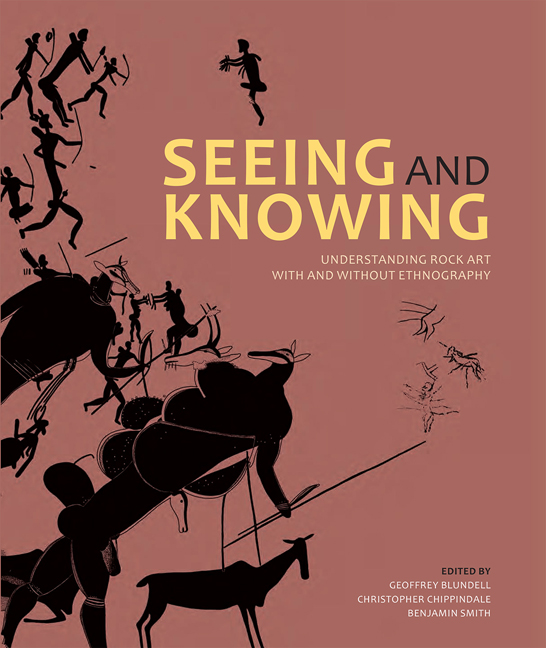Book contents
- Frontmatter
- Dedication
- Contents
- Contributors
- Acronyms
- Chapter 1 Rock art with and without ethnography
- Chapter 2 Flashes of brilliance: San rock paintings of heaven's things
- Chapter 3 Snake and veil: The rock engravings of Driekopseiland, Northern Cape South Africa
- Chapter 4 Cups and saucers: A preliminary investigation of the rock carvings of Tsodilo Hills, northern Botswana
- Chapter 5 Art and authorship in southern African rock art: Examining the Limpopo-Shashe Confluence Area
- Chapter 6 Archaeology, ethnography, and rock art: A modern-day study from Tanzania
- Chapter 7 Art and belief: The ever-changing and the never-changing in the Far west
- Chapter 8 Crow Indian elk love-medicine and rock art in Montana and Wyoming
- Chapter 9 Layer by layer: Precision and accuracy in rock art recording and dating
- Chapter 10 From the tyranny of the figures to the interrelationship between myths, rock art and their surfaces
- Chapter 11 Composite creatures in European Palaeolithic art
- Chapter 12 Thinking strings: On theory, shifts and conceptual issues in the study of Palaeolithic art
- Chapter 13 Rock art without ethnography? A history of attitude to rock art and landscape at Frøysjøen, western norway
- Chapter 14 ‘Meaning cannot rest or stay the same’
- Chapter 15 Manica rock art in contemporary society
- Chapter 16 Oral tradition, ethnography, and the practice of north American archaeology
- Chapter 17 Beyond rock art: Archaeological interpretation and the shamanic frame
- List of figures
- List of tables
- List of publications by david Lewis-williams
- Index
Chapter 15 - Manica rock art in contemporary society
Published online by Cambridge University Press: 21 April 2018
- Frontmatter
- Dedication
- Contents
- Contributors
- Acronyms
- Chapter 1 Rock art with and without ethnography
- Chapter 2 Flashes of brilliance: San rock paintings of heaven's things
- Chapter 3 Snake and veil: The rock engravings of Driekopseiland, Northern Cape South Africa
- Chapter 4 Cups and saucers: A preliminary investigation of the rock carvings of Tsodilo Hills, northern Botswana
- Chapter 5 Art and authorship in southern African rock art: Examining the Limpopo-Shashe Confluence Area
- Chapter 6 Archaeology, ethnography, and rock art: A modern-day study from Tanzania
- Chapter 7 Art and belief: The ever-changing and the never-changing in the Far west
- Chapter 8 Crow Indian elk love-medicine and rock art in Montana and Wyoming
- Chapter 9 Layer by layer: Precision and accuracy in rock art recording and dating
- Chapter 10 From the tyranny of the figures to the interrelationship between myths, rock art and their surfaces
- Chapter 11 Composite creatures in European Palaeolithic art
- Chapter 12 Thinking strings: On theory, shifts and conceptual issues in the study of Palaeolithic art
- Chapter 13 Rock art without ethnography? A history of attitude to rock art and landscape at Frøysjøen, western norway
- Chapter 14 ‘Meaning cannot rest or stay the same’
- Chapter 15 Manica rock art in contemporary society
- Chapter 16 Oral tradition, ethnography, and the practice of north American archaeology
- Chapter 17 Beyond rock art: Archaeological interpretation and the shamanic frame
- List of figures
- List of tables
- List of publications by david Lewis-williams
- Index
Summary
STUDYING ROCK ART IN MANICA PROVINCE, MOZAMBIQUE
Through archaeological and ethnographic research in the mountainous Mozambican province of Manica, the use of rock shelters as special places through time has been made the focus of study. Many of these shelters are adorned with rock art. Painted images occur on the walls of many shelters formed by the many granite boulders that are characteristic of this rocky terrain (Oliveira 1962: 1; Duarte 1979: 54; Duarte & Duarte 1988: 75). Some of these places play an important role in present rituals and beliefs related to ancestor worship and rainmaking.
Central and southern Mozambique lack any immediate ethnography of the San hunter-gatherers who executed the rock art. However, in Manica there is a 500-year history and ethnography of Shona-speaking people, which also includes relations to some of the painted shelters. Current ethnographic studies are relevant to present-day studies of these people and the management of the cultural heritage there. Can it also shed some light on prehistoric activities in the Manica rock shelters? To what degree can one turn to present Manyika ethnography to learn about the origin of some rituals and beliefs? And can it tell us about the cultural interaction between the early Shona-speaking groups of the region and the hunter-gatherer population who inhabited these lands before they arrived?
THE GEOGRAPHY OF MANICA
The Manica Province stretches along the eastern Zim - bab wean escarpment for about 800 km (Figure 15.1). The border between Mozambique and Zimbabwe generally follows the mountain ranges, cutting through a mountainous and rocky terrain. These peaks may climb as high as 3000 m above sea level; the Manica Valley is situated at 850 m.
Along the eastern foothills of these larger mountains the land slopes steadily downwards towards the lowveld and, finally, the eastern seaboard. The rocky landscape of this part of the Zimbabwean escarpment is strewn with granite ‘whaleback’ hills and hills with broken ‘castle-like’ summits. Underneath the large granite boulders, natural caves and dry shelters are abundant.
- Type
- Chapter
- Information
- Seeing and KnowingUnderstanding Rock Art With and Without Ethnography, pp. 250 - 267Publisher: Wits University PressPrint publication year: 2010



